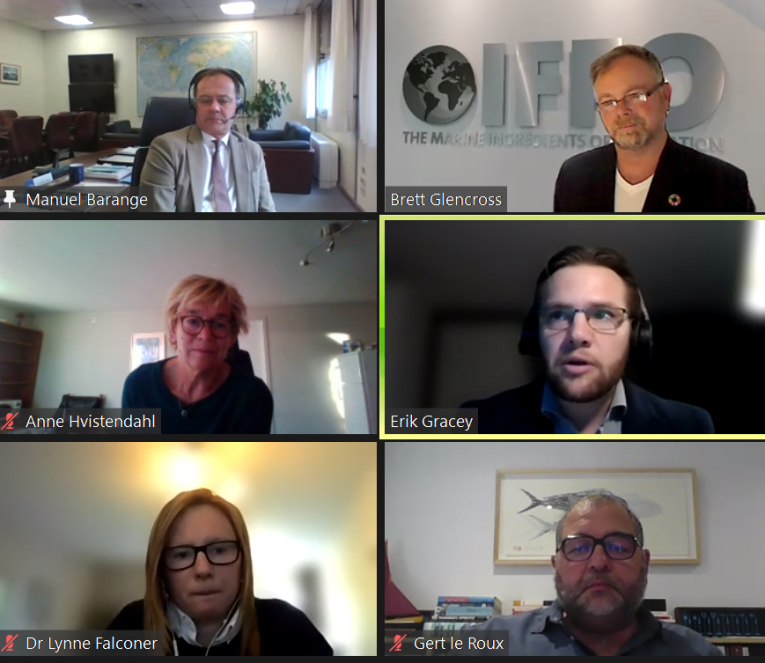IFFO’s October webinar ended with a session dedicated to climate change.
Manuel Barange, FAO’s Director of Fisheries and Aquaculture delivered a keynote speech on impacts on fisheries and aquaculture.
“Climate change is fundamentally a disrupter. Aquaculture is vulnerable and will be impacted. But it is possible to adapt to even though it may be costly” he said.
The heating of climate change is accumulating in the ocean, leading to productivity changes: the warmer the ocean the less nutrients reach the surface. Ocean warming has driven a 4.1% decline in the maximum sustainable yield over the past 80 years. Expected change in maximum catch potential is projected to decrease by up to 12% by 2050, but with very large geographical differences.
Observed rate of range of distributional shifts since the 1950s is estimated to be 51.5 km per decade in near-surface and 29.0 km per decade for near-bottom organisms.
Seasonality changes rely on processes driven both by light cycles (this will not happen earlier) and by temperature (eg. end of plankton hibernation): this will happen earlier.
Climate change will therefore disrupt institutions, management systems, fishing operations, offloading/ processing, market and consumption patterns. Mitigation is the only solution to resolve climate change. But adaptation is crucial as well. “Adaptation can be more than a zero-sum game, if properly implemented” he stated, meaning it should be place and context based, founded on what is possible rather than what is probable, and seen as a strong encouragement for improved fisheries management.
 The panel discussion that followed was moderated by Dr Brett Glencross, IFFO's Technical Director, and involved representatives of the value chain.
The panel discussion that followed was moderated by Dr Brett Glencross, IFFO's Technical Director, and involved representatives of the value chain.
Building on Manuel Barange’s considerations, all panellists emphasized that adaptation becomes possible only if it is followed throughout the value chain. Barange underlined the need to educate consumers to new fish species, insisting that the Paris agreement has a specific adaptation goal focusing on food production.
Carbon footprint
Erik Gracey, Global Sustainability Specialist at BioMar, outlined the Group’s ambition to go net zero no later than 2050: “Calculations of carbon footprint demonstrate that marine ingredients are lower than the other ingredients. We have to know our raw materials a lot better, have a broader portfolio. Our customers (fish and shrimp farmers) want to know how carbon footprint is calculated. Strong requirements are also coming from the financial sector.” The circular economy is part of the strategy: Aquaculture by-products are low carbon materials: because the fillet goes to direct human consumption, most of the carbon footprint goes to human consumption, according to life cycle assessment calculations.
Incentivizing the market
Anne Hvistendahl, Global Head Seafood at DNB, Norway, underlined that climate change ranks at the top of key indicators. “The feed sector is key to meet the requirements in the seafood sector” she explained. “The footprint of marine ingredients is much better than most of the other ingredients’.” The shift in the financial sector is quite recent as 5 years ago regulators were pushing for sustainability credentials. “Now it comes from banks. This pressure is much stronger than regulators. Consumers are also very powerful” she explained.
Adaptation is underway
Moving to the aquaculture sector, Dr Lynne Falconer from the Institute of Aquaculture, Stirling, UK, is witnessing the implications of climate change in Scotland: “Farmed fish are subject to what is going on. You can’t wait until the consequences are here. You need to adapt in advance. Increased temperatures imply potential diseases. Low rainfalls are becoming more frequent and may generate health problems.” She mentioned actions being taken by farmers such as deeper nets and more robust cages. But the solution lies in the value chain: feed composition can help produce more robust fish. “The pieces of the jigsaw must meet together”.
Looking at the retail strategy, climate change is regarded as the major threat to food systems, stated Gert Le Roux, Aquaculture and Fisheries Specialist at Woolworths Foods, South Africa. Woolworths Foods aim at reducing carbon emissions by 20% by 2030 and sourcing energy from renewable sources. There is a growing focus on certification and NGO compliance. “We need to engage with our supply chain much more actively. We have a responsibility to raise awareness and demonstrate ambition, try and increase seafood sells, develop new species, make them more palatable for consumers and educate our customers”. KPIs linked to climate change are key in the relationship Woolworths Foods is building with its suppliers, he explained and these requirements are now embedded in daily operations.








